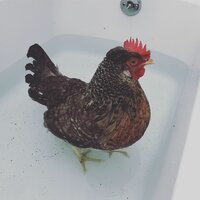UrbanHomesteadMama
In the Brooder
Hi All,
I’m a bit worried about my Olive egger. She was egg bound with a soft egg twice in the last couple months to the point where I gave her warm bath and brought her inside. Thankfully both times the rest came out. I added oyster shells in another dish to the coop (it’s in their food too) and cut out treats and after a few day break she laid two normalish eggs- they had lots of calcium deposits on them and weren’t as green but they were hard. Then she started laying eggs overnight or early morning outside the box. They are almost always smashed bc the shells are so thin. If they aren’t they are dinged up and super fragile. We’re going on day5 of this. I’m glad she’s passing then safely but I would like to eat eggs from her again too! Any thoughts? Do you think it’ll work itself out? I’m a little worried she got a bit of damage from all the internal eggs.
I’m a bit worried about my Olive egger. She was egg bound with a soft egg twice in the last couple months to the point where I gave her warm bath and brought her inside. Thankfully both times the rest came out. I added oyster shells in another dish to the coop (it’s in their food too) and cut out treats and after a few day break she laid two normalish eggs- they had lots of calcium deposits on them and weren’t as green but they were hard. Then she started laying eggs overnight or early morning outside the box. They are almost always smashed bc the shells are so thin. If they aren’t they are dinged up and super fragile. We’re going on day5 of this. I’m glad she’s passing then safely but I would like to eat eggs from her again too! Any thoughts? Do you think it’ll work itself out? I’m a little worried she got a bit of damage from all the internal eggs.




